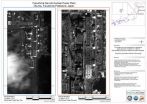(Press-News.org) Japan needs maps. Not just any kind—detailed informational maps georegistered with latitude and longitude and annotated with simple, self-evident details: this bridge is out, this port is damaged, this farm field is scoured; this one is verdant.
Researchers at Rochester Institute of Technology are processing satellite imagery of regions in Japan affected by the 9.0 magnitude earthquake and tsunami that devastated sections of the country's east coast on March 11. The U.S. Geological Survey, a member of the International Charter "Space and Major Disasters," organized the volunteer effort involving about 10 organizations, including Harvard University, George Mason University, Penn State and the Jet Propulsion Laboratory.
RIT signed on to process images of the Fukushima Nuclear Power Plant and the cities of Hachinohe and Kesennuma. At the request of the Japanese, scientists at RIT created before-and-after images that can be printed on large sheets of paper. The team uploads 30 megabyte PDFs to the U.S. Geological Survey's website for charter members and Japanese emergency responders to access.
"Once we upload it, it's out of our hands," says David Messinger, associate research professor and director of the Digital Imaging Remote Sensing Laboratory in RIT's Chester F. Carlson Center for Imaging Science. "If you have the electronic version, you can make measurements on it," he says. "The assumption is they want the big format so they can print it out, roll it up and take it into the field."
The Japanese relief workers requested high-resolution images of the Fukushima Nuclear Power Plant. The RIT team processed imagery looking down into the reactors and the containment shells on March 12, the day after the earthquake and tsunami hit and prior to the explosions at the plant. High-resolution image-maps from March 18 show extensive damage and a smoldering reactor.
"We were tasked with the nuke plant Friday [March 18] morning and we uploaded it about 6 that night," says Don McKeown, distinguished researcher in the Carlson Center for Imaging Science.
The 13-hour time difference has made the workflow difficult, Messinger notes. "While we're doing this here, it's the middle of the night there, so the feedback loops are slow.
"We were pushing hard," he adds. "We wanted to get maps to them before their morning work shift started."
They are mapping the area around the power plant as well, processing imagery from a broader view of the terrain used as farmland.
"We have a large image of Fukushima," McKeown adds. "We're committed to making a big map of this area. This is a very agricultural region and there are restrictions about food coming out of the area."
The RIT team, led by McKeown and Messinger, includes graduate students Sanjit Maitra and Weihua "Wayne" Sun in the Center for Imaging Science and staff members Steve Cavilia, Chris DiAngelis, Jason Faulring and Nina Raqueño. They created the maps using imagery from WorldView 1 and WorldView 2 satellites operated by Digital Globe, a member of RIT's Information Products Laboratory for Emergency Response (IPLER), and GeoEye 1, a high-resolution commercial satellite operated by GeoEye Inc.
"This really fits what IPLER is all about—information products," McKeown says.
RIT and the University at Buffalo formed IPLER six months before the earthquake struck Haiti in January 2010. Connections with industry partners led RIT to capture and process multispectral and LIDAR images of Port-au-Prince and surrounding towns for the World Bank.
"With Haiti, we learned how, in a disaster, to send an imaging instrument into the field, collect the relevant data, get it back to campus and do the right processing to the imagery," Messinger says. "In this case, we're learning how to take imagery that we didn't collect and produce the actual product that will be delivered to the first responders in the field in a very short time frame. We've learned a lot about the second phase of the process now."
INFORMATION:
RIT researchers help map tsunami and earthquake damage in Japan
Geospatial information maps created for Fukushima, Hachinohe and Kesennuma
2011-03-25
ELSE PRESS RELEASES FROM THIS DATE:
Changing Misconceptions About Immigration
2011-03-25
When French president Nicolas Sarkozy recently declared that France's efforts at "multiculturalism" were a failure, it reminded those of us in the United States that we're not the only country in the world grappling with issues related to foreign immigration. But while European countries have tended to focus on the cultural side of the immigration debate, Americans are often focused on the perceived economic problems of immigration. As it turns out, Americans have less to worry about on both fronts than the current rhetoric might lead one to believe.
Economically, immigrants ...
Study: Teachers unaware of growing gender gaps in classrooms
2011-03-25
CHAMPAIGN, Ill. – A gap in reading and math scores still exists in lower grades, with boys continuing to outpace girls in math, and girls ahead of boys in reading, two University of Illinois education professors say.
Using national longitudinal data to perform their analysis, Joseph P. Robinson and Sarah Lubienski investigated male and female achievement in math and reading, looking for when gender gaps first appeared and where in the distribution the gaps were most prevalent.
Except for kindergarteners in the 99th percentile, boys and girls generally start out on equal ...
ATVs Remain Dangerous and Prone to Accidents, Crashes
2011-03-25
A recent death of a 12 year old in Florida highlights the danger inherent in the operation of All Terrain Vehicles (ATVs). Since their introduction in the early 1980s, ATVs have resulted in thousands of deaths and hundreds of thousands of emergency room visits.
While the designs have changed from the original 3-wheel, tricycle layout of the first Honda ATV, what hasn't changed is the danger posed by using these recreational vehicles. Since 1982, Florida has reported 447 deaths in connection with ATVs.
Nationwide, in the same period, at least 10,000 people have died ...
Around 25 percent of health messages in Spanish text books are not based on scientific evidence
2011-03-25
Most school text books contain messages about health, but 24.6% of these are not based on any scientific evidence, according to a study by the Knowledge Management Unit at Baza Hospital (Granada), published in the journal BMC Public Health.
"We analysed a total of 844 health messages in primary and secondary school text books in order to identify the level of scientific evidence underpinning these texts, and we classified them into three categories – messages with a high, medium or low level of evidence, messages with an unknown level of evidence, and messages with no ...
A Motorcycle Helmet: Use It or Lose It?
2011-03-25
The National Transportation Safety Board (NTSB) recently issued a press release putting mandatory motorcycle helmet use on its Most Wanted List of Transportation Safety Improvements.
It reported that from 1997 through 2008, the number of motorcycle fatalities more than doubled during a period when overall highway fatalities declined
The NTSB has recommended that everyone riding a motorcycle be required to wear a helmet. Currently, only 20 states, the District of Columbia and four territories have universal helmet laws that apply to all riders.
Twenty-seven states ...
Atlanta Airport Hotel Offers Nearby Lodging to Travelers Visiting Fernbank NatureQuest
2011-03-25
The Hampton Inn & Suites Atlanta Airport Hotel (North I-85) offers nearby accommodations to travelers planning to visit the Fernbank Museum of Natural History near midtown Atlanta. The Museum recently launched a new permanent exhibition, Fernbank NatureQuest. Guests can climb trees and cross rope bridges to a working clubhouse, which sits atop giant trees. Tickets for Fernbank NatureQuest are included with Museum admission and free for all members.
Fernbank's other permanent exhibitions include:
- Dinosaur Entrance Plaza
- Giants of the Mesozoic
- A Walk through Time ...
BrainGate neural interface system reaches 1,000-day performance milestone
2011-03-25
PROVIDENCE, R.I. [Brown University] — Demonstrating an important milestone for the longevity and utility of implanted brain-computer interfaces, a woman with tetraplegia using the investigational BrainGate* system continued to control a computer cursor accurately through neural activity alone more than 1,000 days after receiving the BrainGate implant, according to a team of physicians, scientists, and engineers developing and testing the technology at Brown University, the Providence VA Medical Center, and Massachusetts General Hospital (MGH). Results from five consecutive ...
Against the tide: Currents keep dolphins apart
2011-03-25
Conservationists from the Wildlife Conservation Society, the American Museum of Natural History, and other conservation and research groups have discovered that groups of dolphins in the western Indian Ocean do not mix freely with one another. In fact, dolphin populations are kept separate by currents and other unseen factors.
Specifically, the researchers have found that genetically distinct populations of the Indo-Pacific humpback dolphin may be formed in part by currents, surface temperature differences, and other environmental barriers, a finding made possible by ...
Debenhams Launches Android & Nokia Apps for Shoppers on the Move
2011-03-25
Debenhams has launched its latest app for the professional shopper on Android and Nokia phones, making the retailer the first on the high street to offer apps for the three key smartphones.
The free-to-download, fully transactional apps follow the highly successful launch of the Debenhams iPhone app in October 2010. Designed to target the on-the-move shopper and enrich the in-store experience, the Debenhams iPhone app achieved 360,000 downloads and sales of nearly GBP1 million within five months of launch.
With the success of the iPhone app and sales on the Debenhams ...
Eskimo study suggests high consumption of omega-3s reduces obesity-related disease risk
2011-03-25
SEATTLE – A study of Yup'ik Eskimos in Alaska, who on average consume 20 times more omega-3 fats from fish than people in the lower 48 states, suggests that a high intake of these fats helps prevent obesity-related chronic diseases such as diabetes and heart disease.
The study, led by researchers at Fred Hutchinson Cancer Research Center and conducted in collaboration with the Center for Alaska Native Health Research at the University of Alaska-Fairbanks, was published online March 23 in the European Journal of Clinical Nutrition.
"Because Yup'ik Eskimos have a traditional ...
LAST 30 PRESS RELEASES:
Numbers in our sights affect how we perceive space
SIMJ announces global collaborative book project in commemoration of its 75th anniversary
Air pollution exposure and birth weight
Obstructive sleep apnea risk and mental health conditions among older adults
How talking slows eye movements behind the wheel
The Ceramic Society of Japan’s Oxoate Ceramics Research Association launches new international book project
Heart-brain connection: international study reveals the role of the vagus nerve in keeping the heart young
Researchers identify Rb1 as a predictive biomarker for a new therapeutic strategy in some breast cancers
Survey reveals ethical gaps slowing AI adoption in pediatric surgery
Stimulant ADHD medications work differently than thought
AI overestimates how smart people are, according to HSE economists
HSE researchers create genome-wide map of quadruplexes
Scientists boost cell "powerhouses" to burn more calories
Automatic label checking: The missing step in making reliable medical AI
Low daily alcohol intake linked to 50% heightened mouth cancer risk in India
American Meteorological Society announces Rick Spinrad as 2026 President-Elect
Biomass-based carbon capture spotlighted in newly released global climate webinar recording
Illuminating invisible nano pollutants: advanced bioimaging tracks the full journey of emerging nanoscale contaminants in living systems
How does age affect recovery from spinal cord injury?
Novel AI tool offers prognosis for patients with head and neck cancer
Fathers’ microplastic exposure tied to their children’s metabolic problems
Research validates laboratory model for studying high-grade serous ovarian cancer
SIR 2026 delivers transformative breakthroughs in minimally invasive medicine to improve patient care
Stem Cell Reports most downloaded papers of 2025 highlight the breadth and impact of stem cell research
Oxford-led study estimates NHS spends around 3% of its primary and secondary care budget on the health impacts of heat and cold in England
A researcher’s long quest leads to a smart composite breakthrough
Urban wild bees act as “microbial sensors” of city health.
New study finds where you live affects recovery after a hip fracture
Forecasting the impact of fully automated vehicle adoption on US road traffic injuries
Alcohol-related hospitalizations from 2016 to 2022
[Press-News.org] RIT researchers help map tsunami and earthquake damage in JapanGeospatial information maps created for Fukushima, Hachinohe and Kesennuma



